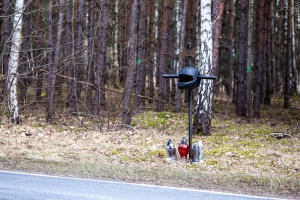Should NH crack down on roadside memorials?

You’ve seen them as you drive down the highway: wooden crosses or other homemade monuments on the side of the road memorializing someone who passed away in a car accident. These memorials occupy a legal gray zone in New Hampshire, but that hasn’t stopped them from becoming commonplace and increasingly ornate. A bill in the Legislature would crack down on roadside memorials and direct Department of Transportation workers to dispose of them 90 days after the incident.
The law and roadside memorials
Under RSA 236:29, the Department of Transportation has the authority to remove obstructions from most types of highways in New Hampshire. However, it’s not always clear what qualifies as an “obstruction.” Sure, if someone erects a large granite monument to a loved one along a state highway, this would clearly count as an obstruction, since it could block a driver’s view and could cause injury if someone crashed into it. A wooden cross isn’t so clear-cut.
According to New Hampshire’s Department of Transportation, the law just isn’t explicit enough. As you might imagine, the family members who created these memorials are often outraged when D.O.T. workers remove them. The Department believes that HB 1553 could clarify the rules around roadside memorials and reduce these conflicts.
HB 1553
HB 1553 is a 2022 bill written to give more “teeth” to the current law. It prohibits a roadside memorial located within the right of way of any primary or secondary highway and requires the Department of Transportation to remove any roadside memorial after 90 days from the date of the event being memorialized. (That last detail is important, because it would stop someone from simply erecting a new memorial every 90 days.) The bill would add this text to the existing statute: “No roadside memorials are permitted within the right of way of any primary or secondary highway. If not removed pursuant to RSA 236:29, I, the department of transportation shall remove and dispose of any roadside memorial after 90 days commencing from the date of the event being memorialized.”
Addressing a growing problem
Rep. Daniel Eaton (D-Stoddard), who is sponsoring the bill, argues that roadside memorials in New Hampshire have gotten out of hand. While the tradition of marking a fatal crash site with a wooden cross dates back decades or more, it has become more common to make permanent memorials on the roadside, complete with battery-operated lights, artificial flower arrangements, and other accessories. Rep. Eaton and other proponents of this bill say these memorials are a safety hazard for a number of reasons. For one, they are distracting to drivers. Also, they often result in cars parked on the side of busy roads while family members tend to the monuments—which puts them at risk of being struck by passing cars.
There are other arguments for cracking down on roadside memorials. They make it harder for road crews to mow and maintain the area around the road. They can also cause complicated situations in which D.O.T. workers become the “bad guys”. For example, imagine an accident taking place on a highway where a drunk driver causes a crash, killing another driver. Then both families want to put up memorials to their dead loved ones; one commemorating the drunk driver and another honoring the victim. Ultimately, D.O.T. is then brought into the middle of the dispute.
An unnecessary step with unintended consequences?
During the Senate Transportation Committee’s hearing on this bill, some senators took issue with the bill as it is written. For example, Sen. David Watters (D-Dover) argued that the D.O.T. already has all the authority it needs to take down roadside memorials. He also pointed out that the bill seems somewhat self-contradictory; if these memorials are prohibited, why wouldn’t they be removed immediately rather than waiting 90 days?
Lastly, Sen. Watters pointed out that the bill text reads “the department of transportation shall remove and dispose of any roadside memorial after 90 days.” The use of the word “shall” rather than the word “may” could create problems for the D.O.T. if they failed to remove the monuments as the law demands.
What do you think?
While this issue might seem trivial, it has many Granite Staters fired up on both sides. Some think roadside memorials have grown increasingly gaudy and even hazardous, and believe HB 1553 would address the problem. Others think they are an important and moving reminder for all motorists to drive cautiously. Whichever side you fall on, you can tell your state senator how you think they should vote on HB 1553. To get started, visit our Elected Officials page to learn who represents you and how to contact them.
Update: The Senate killed HB 1553. Click here to explore the latest legislative proposals related to motor vehicle laws.











Comments
Login or register to post comments